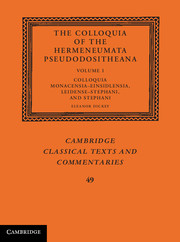The colloquia and their context
from Part One - Introduction
Published online by Cambridge University Press: 05 May 2013
Summary
I got up in the morning, having been woken up, and I called a slave boy. I told him to open the window; he opened it quickly. Having gotten up, I sat on the frame of the bed. I asked for shoes and leggings, for it was cold. So then having been shod I received a linen towel. A clean one was handed to me. Water was brought for my face in a little jug. Doused by which water, first as to my hands, then onto my face, I washed myself; and I closed my mouth. I scrubbed my teeth and gums. I spat out the undesirable stuff as it accumulated, and I blew my nose. All these things were expelled. I dried my hands, then also my arms and my face, in order to go out clean. For thus it is fitting for a freeborn boy to learn. After this I asked for a stylus and my book; and I handed over these things to my slave boy. So having been prepared for everything, I went forth with a good omen, with my paedagogue following me.
(S 3a–8a)So begins a bilingual description of a child’s day found in a sixteenth-century collection of glossaries. What is this work? Is it an original essay by a schoolboy, an easy reader for small children just learning their letters, a text for Latin speakers to learn Greek on, or a text for Greek speakers to learn Latin on? Is it a product of the first century ad, the early third century, late antquity, or the Renaissance? If ancient, does it come from the Western empire or from the East? Is it in its original form, or has it been damaged in transmission – for example, why does the child take such care over personal hygiene and then, on a cold day, go off to school apparently naked from the knees up?
- Type
- Chapter
- Information
- The Colloquia of the Hermeneumata Pseudodositheana , pp. 3 - 56Publisher: Cambridge University PressPrint publication year: 2012

